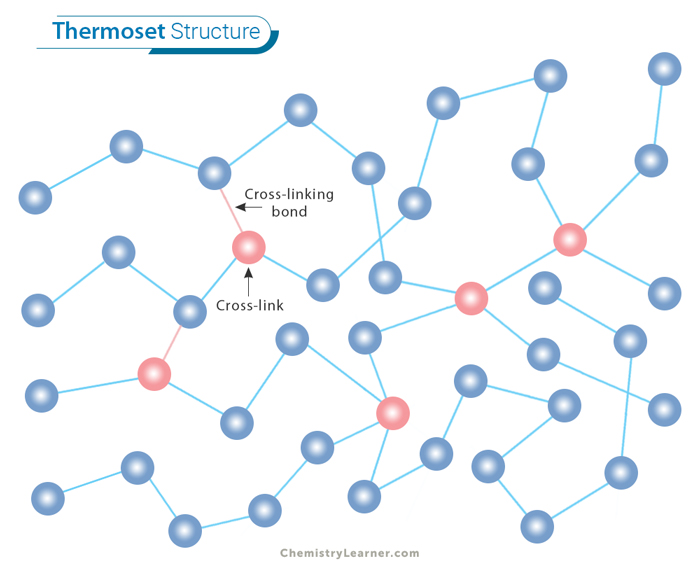Thermoset Plastic
Thermoset plastic is a polymer that undergoes a chemical reaction during curing. This reaction creates strong cross-links between the polymer chains, creating a rigid and durable material. [1,3,4,5]
Characteristics of thermoset plastic include its ability to withstand high temperatures without melting or softening, excellent dimensional stability, and superior chemical resistance compared to thermoplastics. Once cured, a thermoset cannot be remolded or reshaped like thermoplastic, making it ideal for high-strength and stability applications.
Thermoset Examples
Here are some examples of thermoset materials and their key properties: [1,2,4,5,7]
1. Epoxy Resin: Epoxy resins are versatile thermosetting polymers widely used in adhesives, coatings, and composite materials. They exhibit excellent adhesion, chemical resistance, and mechanical properties after curing.
2. Phenolic Resin: Phenolic resins, derived from phenol and formaldehyde, are heat-resistant thermosetting polymers. They are commonly used in producing molded products and laminates and as binders for friction materials.
3. Polyurethane: Polyurethanes are formed by the reaction of polyols and isocyanates. They are used in foams, coatings, adhesives, and elastomers. Polyurethanes offer many properties, including flexibility, hardness, and resilience.
4. Melamine Formaldehyde Resin: Melamine formaldehyde resins are thermosetting polymers known for their excellent heat and chemical resistance. They are commonly used in laminates, coatings, and molded products such as dinnerware and kitchenware.
5. Bakelite (Phenolic Formaldehyde): Bakelite is a historic thermosetting polymer that played a significant role in the early development of plastics. It is a phenolic formaldehyde resin known for its electrical insulating properties and heat resistance.
6. Polyimide: Polyimides are high-performance thermosetting polymers with exceptional heat resistance and mechanical strength. They find applications in aerospace, electronics, and other industries requiring extreme performance.
7. Diallyl Phthalate (DAP): Diallyl phthalate is a thermosetting polymer known for its electrical insulating properties and resistance to heat and chemicals. It is commonly used to produce electrical components and high-performance molded parts.
8. Cyanate Ester Resin: Cyanate ester resins exhibit excellent high-temperature stability and low outgassing properties. They are used in aerospace and electronic applications where thermal performance is crucial.
9. Unsaturated Polyester Resin (UPR): Unsaturated polyester resins are widely used in producing fiberglass-reinforced plastics (FRP). They offer good strength, corrosion resistance, and dimensional stability after curing.
Applications
Thermosetting polymers find extensive applications across various industries due to their unique properties and versatility. [1]
Electrical Insulation: Thermosetting plastics, such as epoxy resins, are widely used for electrical insulation. They provide excellent dielectric properties, thermal stability, and resistance to electrical breakdown, making them suitable for insulating components in electronic devices and electrical systems.
Adhesives and Sealants: Thermosetting plastics like phenolic resins and polyurethane can be used to formulate adhesives and sealants. These materials can bond to different surfaces effectively and provide durable and strong adhesion.
Advantages
Using thermoset materials offers a range of advantages over thermoplastics in various manufacturing applications. Thermosetting resins, in particular, provide unique benefits that make them preferred choices for many industries. [1,7]
Some advantages of using thermoset materials include:
- Superior thermal and chemical resistance compared to thermoplastics
- Enhanced dimensional stability and durability, making them ideal for high-stress applications
- Excellent electrical insulation properties, crucial in electronic and electrical components
- Ability to withstand higher temperatures without deformation or softening
- Reduced material waste during processing due to the irreversible curing process
Disadvantages and Challenges
Thermosetting polymers, while offering many benefits, also come with their own set of limitations and challenges. One of the main disadvantages of thermosets is their inability to be remolded or recycled easily. Once cured, they cannot be melted down and reshaped like thermoplastics. [1,7]
This limitation poses a significant challenge in terms of sustainability and environmental impact. The recycling of thermoset materials is a complex and costly process, often involving grinding or crushing the material for reuse in lower-grade applications.
Moreover, the disposal of thermoset products at the end of their life cycle can contribute to waste management issues. Finding innovative solutions for recycling and repurposing thermosetting polymers is crucial in addressing these challenges and reducing their negative environmental impact.





